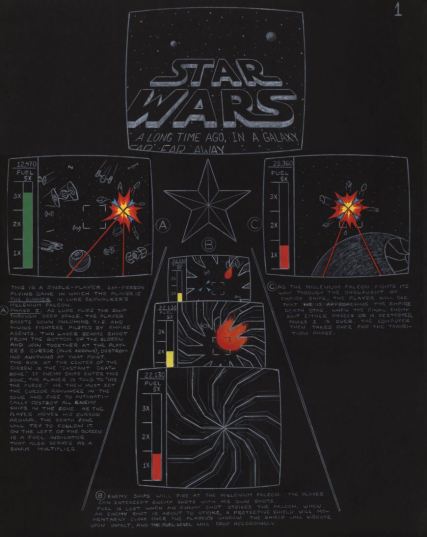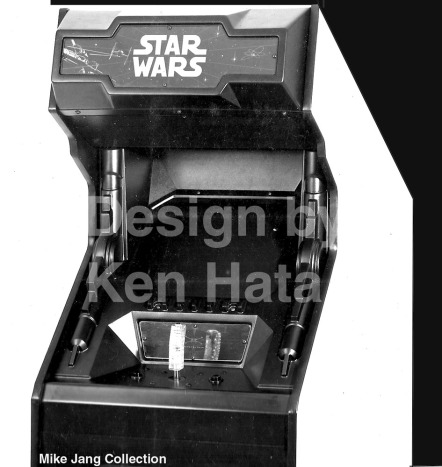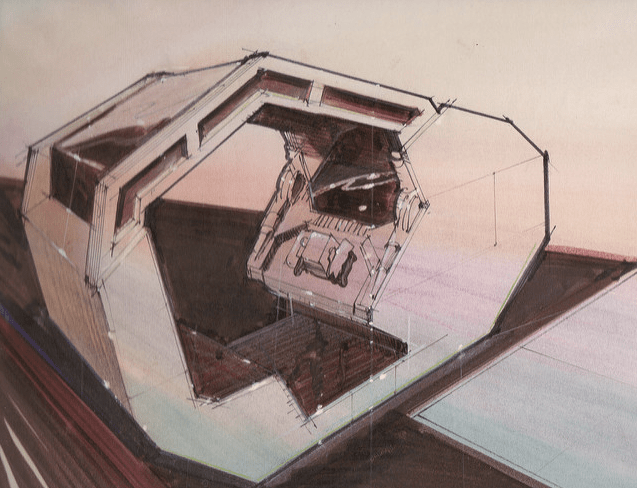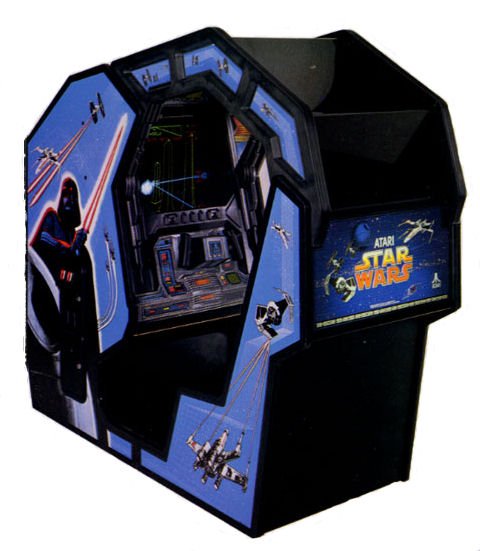Ask any fan of Golden Age classic arcade machines what their fondest recollection of the era is, and it is likely that Atari’s seminal Star Wars game is going to be mentioned by most. Released in 1983, the game is indeed a true classic and is arguably one of the best uses of a licence ever in a video game. Based on the action seen in the film, this full colour vector game drops the player into the Star Wars Universe. And despite being ultimately not much more than an on-rails shooter, it is a great game, that puts the player inside an X-Wing Fighter craft as Luke Skywalker travelling through space to shoot down enemy Tie-Fighters.
Once the enemies are cleared the player arrives at the Death Star to shoot down Towers and turrets, all the while being encouraged to “use the force” by a digitized Alec Guinness. But it is perhaps the game’s final sequence that captures the imagination the most; the player is able to barrel down the Death Star’s “trench” to the game’s ultimate spectacular grand finale:
Released in two formats, it is undoubtedly the Cockpit version that most players hold dear to their hearts.

The actual game started life as something else entirely – Warp Speed. This was the game that engineer Jed Margolin had in his head to develop from his very first day at Atari:
The Star Wars game came about because I wanted to do a 3D space war game. I mean, I really wanted to do a 3D space war game. It is why I went to work for Atari.
After the distraction of having to prove himself on other Atari titles like Sebring, Battlezone and Tube Chase, Jed was finally given the green light to get his pet project off the ground, with Greg Rivera taking up programming duties, and Mike Hally appointed as project leader. Mike had joined Atari to work within its short-lived Pinball division. Talking to Retro Gamer magazine (Issue 149) he spoke about the project:
I think that was the most excited I’ve ever been in my life! They could have picked people like Ed Logg or Ed Rotberg, who had superiority over me. I’d just come off the Gravitar and Akka Arrh games, but for some reason they choose me to run the project and design the game. I didn’t know how much work it was going to be but I wanted to make sure I got the best team and made the best game. Star Wars was such an important title. I just wanted to make sure it was top-notch.
In the original proposal document for Warp Speed from Atari’s archives, some interesting snippets can be pulled out:
Player moves through free space to attack and shoot down opposing spaceships originally in formation. Spaceships break formation and fire at player. Possibly the player’s shot can collide and cancel with an opponent’s shot….
Surmising the end of a wave, the document goes on to say:
….If the player hits it, he is treated to a colourful display or explosion and gets one free turn (free life) then continues to the next wave of normal game play….
In conclusion the document states:
….A feeling similar to the end of Star Wars can be achieved by the player and is a desirable goal.
Which if you are familiar with the arcade game Star Wars, all sounds eerily familiar…

At some point during the development of Warp Speed, Atari agreed a partnership with Lucasfilm, picking up the rights to develop new games under the Star Wars franchise. Sensing an opportunity to attach his game to this high-profile IP, Jed suggested to the powers that be at Atari that his vision for Warp Speed would be a sound platform on which to build a Star Wars themed game. Management duly agreed, perhaps with some relief that someone had proactively suggested a solution to a tricky project.
Hally was aware of some of the challenges facing the team:
[The game] seems simple now but it was kind of 3D, we had to develop the hardware, the cabinet and the controller; this was key to how it played… then we had to get everything approved by Lucas, which added to how long it all took.
Like most games, several elements were considered and then dropped or adapted to improve the player experience during the development of Star Wars. Here are a couple of story boards developed by Atari when putting the game mechanics together. You can click each image for a larger version:


In an early iteration of the game, the player used a simple joystick to pilot the craft.
This very rare photograph was shared with me by one of Atari’s designers. It shows the original joystick controls used on the Star Wars game:

Note the designer Ken Hata made what was called an insert tool for the plastic mold around the monitor. The section for the controls is a removable part of the mold. This allowed it to be interchanged and replaced with a different design if necessary. Note also the very cool molded plastic marquee attraction piece at the top of the cabinet (presumably dropped from the final design). That also was designed by Ken.
This joystick set up was put to a focus group. Feedback from the session was that players were confused about which way they were supposed to move the stick in order to steer their craft. Armed with this information, the team were able to convince Atari to allocate additional budget to develop the iconic flight controller you’ll be familiar with on the machine:

Mechanical engineer Jerry Liachek was responsible for the yoke controller, as well as many other iconic Atari controllers, including the trackball found in Missile Command. It was adapted from the controller used in the Bradley Trainer simulator developed a few years earlier. Although quite a complex piece of equipment, it was very intuitive for the player to use – placing the fire and trigger buttons on the yoke itself gave a more immersive experience compared to traditional arcade control set ups.
Synthesized speech was added to the game, using clips from the film. This was a first for Atari. Various familiar phrases were used in-game such as “Use The Force, Luke” and “Yahoo, you’re all clear kid!” are used to encourage the player, and of course add to the sense of “being there”. Hally tells us that implementing this speech took many hours, but so determined were the team to deliver an outstanding product, they saw the work through.
But it is the cockpit cabinet itself that defined Atari’s Star Wars arcade game. Subject matter and game play elements aside, it is this iconic looking cabinet that drew the quarters and secured its place in the arcade history books. In writing this article, I was able to track down and talk with Mike Jang, who was an industrial designer at Atari. Mike would work with his colleagues in mocking up and designing the physical and ergonomic side of Atari’s arcade machines.
Here, Jang’s colleague Barney Huang sits inside a very early cockpit prototype (made largely of cardboard pieces!). you can make out some similarities to the final Star Wars cockpit from these images:


The Star Wars cockpit was Mike Jang’s baby. Once briefed, he sketched out his vision for the cabinet:

I asked Mike exactly what was involved:
I started the concepts for the Star Wars cabinet and later another designer did more detailed work on the plastic part in front of the monitor. One of the main elements I sketched up were the hydraulic ram shapes on the plastic parts. Those rams were often seen in the movie, especially the ramp to the Millennium Falcon. Also I wanted to continue the mechanical theme by adding that truss style design to the sides of the roof. I was concerned because that was a particle board part that was cut with an angled router bit. Then the bare particle board was just painted black. I was worried about the wood texture appearance but nobody noticed after everything else was put in place.


Hally recalls why the cockpit was so important:
We knew it would be perfect for a sitdown cab as well as a standup. That’s why we made such cool mouldings around the monitor and used this see-through dark Perspex, so people could see what was going on. And we spent a long time working on the controller so [the whole cockpit experience] felt just right.
With the cabinet design approved by Lucasfilm, it was time to start sharing the actual game with them for approval and feedback. Memos went back and forth between Atari and Lucasfilm with ideas and questions about the proposed game. I’ve found an interesting document which details actual feedback from the Lucasfilm team on some of the suggested game play elements proposed by Atari. (I’m guessing the handwriting top right is from Mike Hally himself)
After many tweaks and technical challenges to deliver the vision of its creators, the game was finally ready. 18 month’s hard work were about to come to fruition. Nerves were on edge as Atari invited George Lucas himself to test the completed vector game at Atari’s factory in Sunnyvale California. Thankfully, someone was there to document the event:



That plaque on the side of the cabinet reads: “A special thanks for creating THE FORCE behind so much fun”. The cabinet was presented to Lucas as a gift after his approval of the finished game.
The key difference between the upright and sitdown cockpit cabinets aside from the seating position, was the larger monitor used in the cockpit version of the game. A 25″ Amplifone (vs a 19″ Wells Gardner in the upright) really does add to the impact of the visuals.

So with a thumbs up from the creator of Star Wars himself, the game was put into production and released in 1983. Here is a Projected Materials Cost Estimate document prepped by Mike Hally for the upright cabinet. Makes for interesting reading:
Getting the game out to market was arguably pretty easy – with the attachment of the Star Wars franchise to the game, and housing it inside Mike Jang’s glorious cockpit cabinet, players armed with coins ready to play were drawn in.
Atari made the most of the Star Wars IP attached to their game:

The game sold itself once out on the arcade floor – and in the challenging arcade market of 1983, this was pretty key. Operators looking for ways of getting new footfall to their arcades loved it.
Atari sold just over 12,000 Star Wars cabinets in total, consisting of 10,245 uprights and 2,450 cockpits. With an assumed margin of around $1,000 per cabinet, this was a multi-million dollar earner for Atari’s coin-op division, and I would suggest was one of its greatest arcade games ever, despite being released during Atari’s arcade twilight years.

Atari’s Star Wars remains a classic slice of arcade history. It has everything going for it – great vector visuals, the Star Wars IP, fabulous artwork and an iconic design that holds up to this day. You can find cockpits out there in the wild still. Do try to seek one out and experience the ride.
Props must go to Mike Jang for his assistance and input into this article – thank you Mike.
Thanks for reading this week. Do follow the blog below to be notified of new updates!
Tony

Don Osbourne’s one hell of a smooth guy, isn’t he?
Thanks Tony (and Mike), have been hitting F5 all day for this weeks blog and it did not disappoint. Lots of nice detail I hadn’t heard before.
LikeLiked by 3 people
Tony,
I like the photo of all the guys wearing ties when George Lucas comes to visit. It’s funny because everyone wore jeans and t-shirts to work in those days. If you came into work with slacks and a button down shirt, you’d hear, “Hey man, are you out interviewing?”
Seeing these images I remember now some good coordination with the graphic designers. I asked the graphic designer to have the cab side graphic image flow from the monitor area, continue through the roof trusses and finally down the seat sides. I just noticed now how well the light saber and the two laser beam are pointed toward the roof.
Thanks for the credits. Excellent job, this really took me back to the golden years.
Mike
LikeLiked by 2 people
Thank you again for your insights Mike. Good fun talking!
LikeLike
Great write up Tony on what is indeed an iconic cab. It still maintains the ability to completely transport you into an actual x-wing and transform you into the same excited kid you once were when you first climbed aboard and were engulfed by it’s greatness.
Some good facts and stories dug up from the archivea too, you certainly do your research/lnow your stuff.
I liked the price list for the original units. At $4.00 I rhink2I could just about afford the fluorescent light assembly!
Great stuff.
LikeLiked by 1 person
Hi Mike. A small addition to your story. The game that first came out of Jed’s Space War Warp Speed game idea and hardware was Battlezone. Ed Rotberg created the 3D Space War prototype (Warp Speed) with two cabinets tied together back top back, playing against each other. (I was lucky enough to share a lab with Ed Rotberg, so played with that a lot.) Imagine the 2D Space War game in 3D from inside the cockpit of one of the two ships. It sounded like a blast, but was amazingly difficult to play. Most people had real trouble with free form 3D motion in space, especially with full roll, pitch and yaw. And while screen wrap around (go off the left, show up on the right, etc) works OK on a flat 2D game, but not in 3D space. Sadly, that game was canceled. Ed Rotberg then used that hardware to create Battlezone next. Some time later, Star Wars used similar hardware, with a newer and faster color vector system, and the original controller that was made for Warp Speed.
LikeLiked by 2 people
Back in 84 or 85 I was in Las Vegas and went to an “Atari Experience” arcade that was upstairs in one of the casinos (I don’t remember which one). There they had a Star Wars that was built into a powered motion cabinet. I was pretty good at the game at that time and I remember having a good long go in there and having a few spectators by the time I got out.
I’ve searched in vain for any mention or pictures of this unique Star Wars cab and wondered if anyone passing by here might have seen it or has any information about it, I’d be curious to see or hear anything about it!
LikeLiked by 1 person
Stinky Ox (AKA Grandmaster Minter?)
A hydraulic Star Wars! Surely that’s in the Top 10 of Arcade Unicorns?!
Regarding the article itself, a well researched, well presented and well written insight into one of my all time favourite games and cabs. I first played this in the early 80s at a motorway stop on a school trip. I remember it because almost the whole year group were gathered around the cabinet watching me safe the universe!
LikeLiked by 1 person
This only makes me regret selling my (Irish made) cockpit more….
Mike Jang: thank you for your fantastic work !!!
Since the day I owned it, I wondered one thing about the cockpit vs, the upright though:
Why is the upright mostly black on the sides, but the cockpit blue ?
We all know the colour of space….black….so why the blue ?
The only reason I can think of is that maybe, in dark arcades the machine might have been overlooked if it had been black ?
I once asked this to Jed Margolin and he didn’t know why.
Sincerely hope you can shed some light on this ?
LikeLiked by 1 person